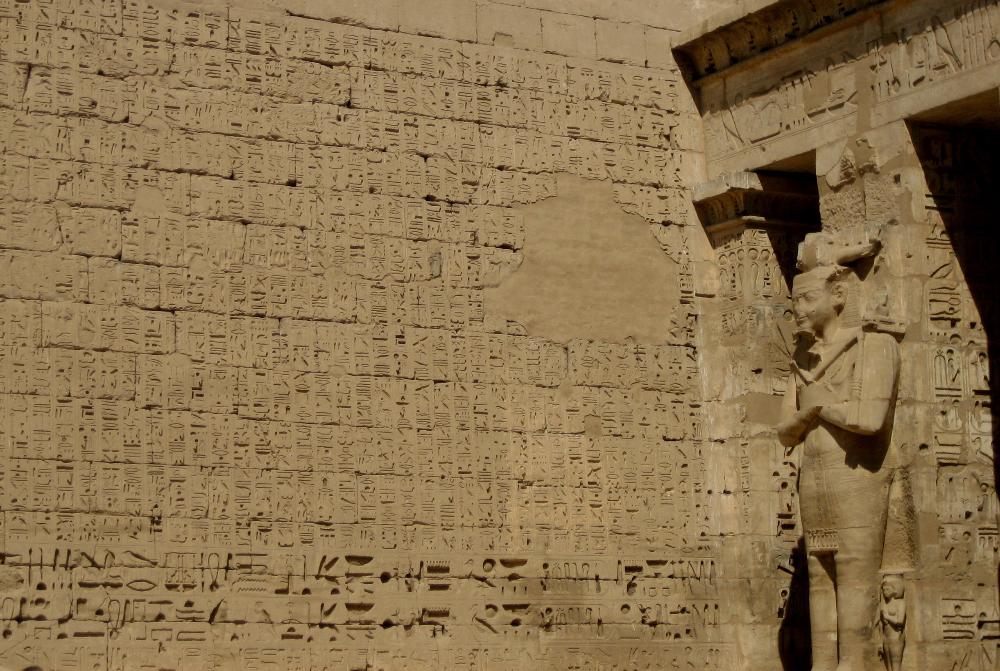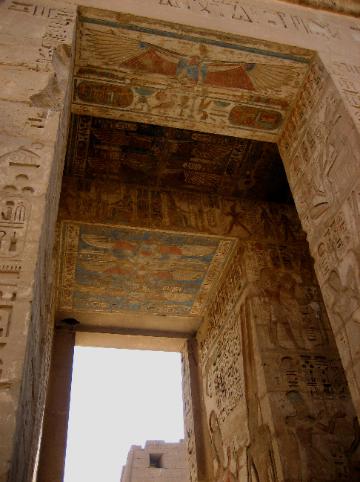
Where We Be



| Simple but lovely carving of lotus leaves (Deir-El-Medina) |
| This confusing and signless warren of homes and hidden tombs greets us at the Valley of the Nobles. You can see why we ended up needing a guide. |
| Luxor, Egypt -- West Bank "Bonus Day" |
| Stunning view of Queen Hatshepsut's Temple from an overlook near the Valley of the Nobles |
| Turbaned Egyptian at Deir El Medina (my favorite photo of the trip) |
| Our impromptu guide at Valley of the Nobles helps us make sense of it all |
| "Before" and "After" photos: smoking applewood tobacco from a sheesha (water pipe) |
| Robin's "Before" and "After" photos -- Applewood smoke smells better than it tastes! But we're glad to have tried this quntessential Egyptian experience at least once. |
| This tent restaurant offers tasty food plus a spectacular view of the Nile River and West Bank |
| Egyptian beer and some of the best bread (right out of a stone oven) we've ever tasted |
| Deir El Medina (Workmen's Village) is a warren of mud-brick chambers that once housed all artisans who worked on the pharaohs' tombs. It was the only village on the West Bank in the time of the pharaohs. Because these artisans knew where the pharaohs were to be buried, their comings and goings were closely monitored: there was only one entrance to the Workmen's Village, and the whole of it was roofed over. |
| Robin shows how deep some cartouches were carved to avoid having them recarved by later pharaohs |
| The outer wall of Medinet Habu is absolutely covered with hieroglyphics |
| Ramses III's fortress-like Temple of Medinet Habu is one of the premier sites to visit on the West Bank |
| Deeply etched carvings in a Ptolemaic temple near Deir-El-Medina |
| Enjoying the oasis of the Luxor Meridien after a full day of sightseeing |
| Richly detailed interior wall at Medinet Habu |
| Ornate doorway at Medinet Habu |
We've set aside a bonus day to explore the
West Bank of Luxor at our own pace. We rent
an air-conditioned car with driver for the day
for about $25 and are driven across to the West
Bank of the Nile. Our first stop is the Valley of
the Nobles, the site we're most keen on seeing.
But when we exit the car, what we see is a
jumble of ramshackle homes on a hillside. We
have no idea where to find the actual tombs, so
we're relieved when a local guide approaches
and offers to show us around.
We've already bought tickets so we're all set to
see the four tombs of Nakht, Menna, Rekhmire,
and Sennefer. All four are phenomenal, with
colors that look as fresh as if they were applied
yesterday. The scenes of domestic life are in
sharp contrast to the stylized and repetitive
depictions from the Book of the Dead so
commonplace in pharaohs' tombs. Here images
are of husbands and wives holding hands,
women preparing for a wedding feast, and men
working in the fields, threshing wheat, fishing,
and even stomping grapes. The tombs are
small but the amount of detail painted onto the
whitewashed walls is astonishing. You can tell
that a harpist is blind, for instance, and you can
easily identify giraffes, monkeys, elephants,
and leopards being led by African emissaries.
Other highlights of our day include a fantastic
overlook of Queen Hatshepsut's temple, a visit
to the Valley of the Artisans to see the tombs of
Sennedjem and Inherka (lovingly decorated by
the artists themselves in their spare time), and
the dramatic fortress temple of Medinet Habu.
West Bank of Luxor at our own pace. We rent
an air-conditioned car with driver for the day
for about $25 and are driven across to the West
Bank of the Nile. Our first stop is the Valley of
the Nobles, the site we're most keen on seeing.
But when we exit the car, what we see is a
jumble of ramshackle homes on a hillside. We
have no idea where to find the actual tombs, so
we're relieved when a local guide approaches
and offers to show us around.
We've already bought tickets so we're all set to
see the four tombs of Nakht, Menna, Rekhmire,
and Sennefer. All four are phenomenal, with
colors that look as fresh as if they were applied
yesterday. The scenes of domestic life are in
sharp contrast to the stylized and repetitive
depictions from the Book of the Dead so
commonplace in pharaohs' tombs. Here images
are of husbands and wives holding hands,
women preparing for a wedding feast, and men
working in the fields, threshing wheat, fishing,
and even stomping grapes. The tombs are
small but the amount of detail painted onto the
whitewashed walls is astonishing. You can tell
that a harpist is blind, for instance, and you can
easily identify giraffes, monkeys, elephants,
and leopards being led by African emissaries.
Other highlights of our day include a fantastic
overlook of Queen Hatshepsut's temple, a visit
to the Valley of the Artisans to see the tombs of
Sennedjem and Inherka (lovingly decorated by
the artists themselves in their spare time), and
the dramatic fortress temple of Medinet Habu.
















